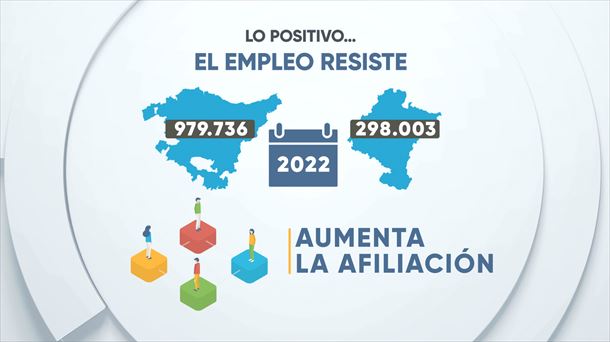The first eight months of 2022 have shown a significant recovery of jobs lost in the pandemic and a spectacular cut in unemployment. Likewise, the private financial position is better than before the arrival of the 2008 crisis.
Euskaraz irakurri: Inflazioaren enbatari eutsi ahal izango gave aurrezki pribatuak?
With a generalized inflationary scenario in practically all of Europe, the pessimism of consumers and downward economic growth forecasts, uncertainty is the majority in society. However, against this gray horizon, there are still positive indicators that seem to place the Basque Country and Navarra in a “favorable” situation to face a crisis that is at our doorstep, according to data from the analysis carried out by EITB DATA.
The pandemic had a strong impact on employment in Hego Euskal Herria, triggering unemployment during the first year; however, the following year, in 2021, with the recovery of normality, the situation gradually recovered until reaching 2022 with very positive data, better than those of 2019, at least until July.

In August, this positive evolution slowed down, something that is usual year after year, with a membership volume that is usually 1% lower than the average for the year in that month. But this 2022, last month has been somewhat worse, with 1.5% fewer workers, although it must be borne in mind that the data for January-July were exceptional.
For this reason, with an “employment base” recovered after the impact of the pandemic, the Basque and Navarrese economies are in a favorable situation to face the coming crisis. Likewise, it has been shown that in the face of an external recession such as that produced by covid-19, the economic and employment fabric in Hego Euskal Herria has been able to recover. And it is that despite the rise in registered unemployment this August, the average value from January to August of this year has left the Basque Country at levels lower than those registered in 2019 and Navarra at values similar to that year.
Less private debt…
Given this situation, another of the indicators to take into account is the volume of private debt, which is lower than that available before the 2008 crisis. In that period, the recession had a very important real estate-financial component that highlighted the high degree of private indebtedness, both family and business.
Since 2009, a process of financial deleveraging has been taking place to reduce the total volume of credit, so that, at present, the debt in Euskadi (-25.5%), Navarra (-33.3%) and Spain (-32.5%) is much lower than that registered before the 2008 crisis. Thus, the private sector, less indebted, currently has a greater capacity to face an economic crisis.
…and more financial muscle
The 2008 crisis and the pandemic have forced continuous private savings in both families and companies despite the low pay in recent years. Thus, the private sector currently has more resources, and the percentage weight of credit over bank savings in 2008 and 2022 has gone from exceeding 100% to being less than that value.
According to the experts, these elements will help counteract the blow of an autumn marked by strong inflation and high energy prices that, however, require “transversal, shared and short-medium-long-term solutions”.
Source: Eitb
With a background in journalism and a passion for technology, I am an experienced writer and editor. As an author at 24 News Reporter, I specialize in writing about the latest news and developments within the tech industry. My work has been featured on various publications including Wired Magazine and Engadget.
